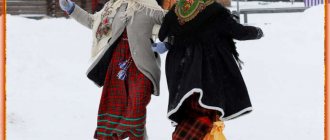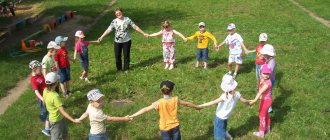Games reflecting the relationship between man and nature
Wolves in the Moat
This game is agile and easy. It can be played by both primary and secondary school children.
On the playground, two horizontal lines are drawn in the center, at a distance of 1 m from each other. A driver is chosen from among the children to act as a “wolf.” If the playing place is large, then you can choose two drivers if you wish.
The “wolves” stand in the space between the lines - this is a ditch, and the rest of the children will be “goats” and they stand behind the “wolf” line. On command, the children must jump over the ditch, and the wolves catch (salat) as many “goats” as possible. After 4-5 jumps over the ditch, a new driver is chosen.
The winner is the one who has never been taunted or the wolf who has caught the most sheep.
Wolves and sheep
You can play in the yard or a spacious room. The number of players is not limited.
To play the game, children, by drawing lots, choose one person to play the role of a shepherd and one to play the role of a wolf, the rest of the children will play sheep.
At opposite ends of the playing field, areas 3-4 steps wide are allocated, which will serve as “pen”.
On one side of the field, a small place is set aside for the wolf and a line is drawn there. The sheep are always in the fold, the shepherd stays close to the flock. As soon as the wolf shouts to the shepherd: “Drive the sheep!”, the shepherd lets his lambs through so that they have time to run to the opposite side of the pen. At the moment when the children are running across the field, a wolf runs out to meet them and begins to kill everyone. The shepherd can interfere with him and try to protect his sheep.
After everyone has run and hid in the corral, those sheep that were molested must go to the wolf and help him catch the next sheep. The winner is the one who has never been caught, and the wolf who, after five races, has caught the most sheep.
Note:
1. Caught sheep have no right to refuse help to the wolf;
2. The wolf does not leave the lair until the sheep leave the fold;
3. Sheep that help the wolf run holding hands, uniting in one large chain.
Lame fox
To play this game you will need a playing area on which you can draw a fairly large circle. Using a counting rhyme, children choose a driver who will play the role of a “lame fox.” After this, the children stand in a circle drawn for them, and outside it there is a fox. At the fox’s command, the children begin to run in a circle past the fox and try not to fall into its “paws.” Meanwhile, the driver must try to grab at least one, and he does this by jumping on one leg. As soon as the “lame fox” insults someone, it quickly runs into the circle, and the one touched becomes the leader.
The game lasts until all the children are in the role of a fox.
Notes:
1. The fox has no right to run on two legs;
2. The fox cannot run into the circle in order to show off;
3. Children should not stand still or in the center of the playground.
Bear and leader
For this game you will need a platform and a rope. The number of players is not limited. One bear and one leader are chosen from among the participants. They grab opposite ends of the rope and the game begins. Children, being at a distance of 4-6 steps, should run up and insult the bear. The leader should not allow this, and tries to protect the bear, and also fires at the attackers.
After the bear is greased 5 times, the leader takes his place, but if he himself greased someone 5 times, then he becomes the leader, and the leader becomes the attacker.
Note:
1. As soon as someone is insulted, he must speak loudly about it himself;
2. You cannot attack a bear without a command;
3. It is not allowed to unhook your hands from the rope.
Cat and mouse
The number of children playing is not limited. The playing field can be a spacious room or an outdoor area.
Children are divided into two teams: “cats” and “mouse”. Chairs are placed in a circle so that the seats face inward.
“Mice” sit on the chairs provided, and the cats stand behind. Pairs are formed in such a way that one cat does not get the mouse, and she stands behind an empty chair, she will start the game and lead.
The task of the free player is the cat, to wink at one of the children who plays the role of a mouse, and lure him to his free chair. The task of the “cats”, who have their own pair, is to try to keep their player and not lose. If they didn’t have time, then they will have to lure the mice to themselves in the same way. After some time, the players change places.
Note: you cannot hold the “mice” by the shoulders all the time.
Kite and hen
The game will require as many participants as possible, from among whom they choose one hen and a kite.
The kite's task is to catch the chicks, which are protected by the hen.
The chickens line up in a column and hold tightly to each other, and the first chicken to the hen. At this time, the kite walks around and looks for the last chicken, which is what needs to be caught. As soon as he begins to attack, the mother hen must protect her chick, hiss at the offender and block his path in every possible way. When turning, the column of “chicks” should flexibly turn after the hen.
As soon as the kite has caught its prey, the chicken leaves the game, the kite continues its hunt until it catches all the chickens.
After all the chicks have been caught, a new kite is chosen.
Note: the brood hen does not have the right to push the kite away with her hands; If one of the chickens accidentally gets unstuck, then the kite can catch up with it and catch it.
Proteins, nuts and cones
Any number of players can take part in this game. The game can be played on the sports ground, in a spare room, or in a gym.
To carry out the game, you will need 1 presenter, 1 driver and children who will play the role of “squirrels”, “cones” and “nuts”.
The driver says: squirrels-cones-nuts, and the children should stand in groups of three, take each other’s hands and close their circle. After this, they agree among themselves who in their “squirrel’s nest” will be the “squirrel”, “nut” and “cone”. The driver does not have a “nest”, and he must get it.
When the leader says: “Squirrels,” those children whose role is named rush to run from their nests to the next one, changing places with the neighboring squirrel. The most important thing is to have time to take a place for yourself, because the driver is aiming to get a place in someone else’s nest. If someone did not have time to find shelter for themselves, and the driver took someone else’s place, then the “squirrel” becomes the driver and will look for a place for itself as soon as the next command is pronounced.
Swan geese
It is best to play this game on a spacious area, where there is some kind of shelter (trees, benches, playhouses, etc.). The number of children is not limited; it is most interesting to play when there are more than 10-12 people. Among the participants, they choose one leader, 1-2 wolves, the rest of the children will pretend to be geese.
Progress of the game: wolves are hiding behind the trees, and geese are grazing nearby (they cannot see the wolves). The leader is on the opposite side of the geese and gives them the command: “Geese-swans, go home, the wolves are roaming under the mountain!” The children begin to run across the area allotted to them, when suddenly wolves run out and begin to salt them.
After several dashes, the number of geese becomes less and less, and the one who remains the very last wins, and the winner among the wolves is chosen by counting the largest number of geese he has killed.
By the bear in the forest
The game is played on any playground or in the park. The number of children in the game is not limited. On one side of the playing field a line is drawn, which is called the “edge”, and a circle is called the “den”. Among the players, using a counting rhyme, they choose a bear who will sit in the den.
Children walk along the edge of the forest and imitate picking berries and mushrooms. The bear sits in a den and pretends to be sleeping. Children get closer and closer to the bear and sing a song:
I'm walking along the edge of the forest. I'm looking at the bear. I take mushrooms and berries. And I’ll run away from the bear! Teddy bear, clumsy bear. He sat down on the bump with his paw, and Bear roared loudly. And he went to catch the children!
After the last phrase, the bear runs out of its den and tries to catch someone. Anyone who has been touched by a bear must go to his den and sit there. Then the game continues the same way. After the bear has caught all the children, he is replaced by the very first one he caught.
Note: it is not necessary to hold a caught child and drag him into the “den”; he can sit on a bench nearby.
"Sticks"
Let's start with a game called "Sticks". Have you heard of this one? I learned about it from my grandmother. She said that when she was little, life was difficult for them; there was not always food in the house, let alone toys. That's why they played with sticks in the street. This fun also has another name - “Crippled”.
You can play in the yard with a large group. It's always more fun to play with a big group! You will need sticks to play. Typical sticks are about 30 - 40 centimeters long and can be easily found in the surrounding area. All players except the leader should have such sticks.
At the leader’s signal, the children place the chopsticks on their palm or finger; they place them, not put them down. And they try to hold the stick in this standing position without holding it with the other hand. The stick, naturally, does not want to stand and tends to fall. In order to hold it, it is necessary to move not only your hand, but also move your legs.
The presenter can “add fuel to the fire” and invite the players to squat or stand on one leg, everything is at his discretion. The one who holds the stick longer than the others wins. And the loser is the one who drops the stick first. He becomes the new presenter.
Games that reflect the daily activities of our ancestors
Seine
This gambling game can be played in the summer in any body of water that has shallows. For greatest safety, you need to choose places where there is no strong current. It is better if many people participate in the game, preferably there should be no less than 6-8. All players are divided into two teams - one team will represent the “fishermen”, and the second - the “fish”. Fish can move throughout the entire territory designated for the game. You should not go into the deepest parts of the river. The goal of the fishermen is to catch as many fish as possible. To do this, fishermen join their hands and try to surround the “prey” with a chain resembling a net. Fish can escape in any way - swimming, diving, moving through shallow water. When the fishermen close the circle and narrow it so that the fish have nowhere to go, the teams change places and the game starts over.
According to some rules, fish can only run away until the fishermen close the circle. After this, the fish that did not have time to escape from the circle are considered caught, since it is not allowed to escape by slipping under the hands of the fishermen.
Fishing rod
This game can be played both on the court and on the water. An inflatable ball is wound onto a skipping rope and spun in a circle, the driver says:
I'll put out a fishing rod and catch a lot of fish. I’ll make some delicious fish soup and invite all my best friends.
If they are playing on the playground, then the children must jump over the “fishing rod”. If the game takes place on the water, then the children must have time to dive so that the ball does not touch them.
The last one standing wins.
Bird catcher
You can play on any site. The number of players is not limited.
At the beginning of the game, a driver is selected and blindfolded. Children come up with some kind of bird whose voice they can imitate and disperse around the playground.
In the forest, in the woods, on a green oak tree. The birds are singing merrily, Ay! The bird catcher is coming! He will take us into captivity, Birds, fly away!
After these words, the driver claps his hands, the children freeze, and he tries to find them. As soon as he finds the player, he asks him to identify himself. The found “bird” must pronounce those sounds that are characteristic of it in nature. The driver’s task is to guess what kind of bird is in front of him and who the child is who is portraying it.
Note: “birds” are not allowed to hide behind objects that will block the path of the “catcher”.
Brook
This game is very old, our grandparents loved to play it. She is cheerful and perky.
A driver is chosen from all the participants, and the rest of the girls and boys, holding hands, become pairs, after which they line up in a column and raise their clasped hands up above their heads. The driver must run along the resulting “corridor” to take someone as his partner and take her to the end of the column. The one whose pair is broken goes to the beginning of the stream and runs the same way as the first driver. Gradually the trickle moves.
The more participants, the more interesting this game becomes.
Previously, in Rus', this game was used to get to know a girl or boy you liked, or simply as fun at folk festivals.
Baba Yaga
Baba Yaga is the most common and famous fairy-tale heroine, who must not only be harmful and evil, but also be able to keep herself in good shape.
This game is very fun and funny. You can play it with the whole family during the holidays or organize a relay test at school.
Relay rules: children must line up in columns one after another. The relay race will be carried out with a bucket on your leg and a broom in your hand. After running a given distance, the players return to the team and pass the baton to the next participant. The team whose members complete this task the fastest wins.
Zarya-zarnitsa
The number of players is not limited. Additionally, you will need a ribbon to play. From all the players, a driver is chosen, the rest of the children stand in a circle and say:
Dawn-lightning, Red maiden, Walked across the field, Dropped the keys, Golden keys, Blue ribbons, Entwined rings - She went for water!
The players standing in a circle hold their hands behind their backs, and the driver walks around the circle and chooses someone to put a ribbon on their shoulder. After the driver has chosen a player for the pair, he puts a ribbon on his shoulder, and they both run sharply in different directions in a circle, the one who does not get an empty seat remains to drive.
Grandfather-horn
Before the start of the game, a driver is selected from among the participants, who is considered a “sorcerer”, “grandfather-horn”. At the initial stages of the game, the grandfather-horn sits in a specially designated “house” (a space outlined on the site), and does not show himself in any way. At this time, the remaining players, having divided into two equal groups, move away in opposite directions from the “house” at a distance of about twenty steps and draw or mark a line with a branch - this is where the house of this part of the players is located. Between the houses of both teams and the grandfather-horn there is a “field”.
The game begins with Grandfather Horn saying:
-Who is afraid of me?
Players from both teams run from house to house across the field, teasing the driver and answering him: “No one is afraid!”
The goal of the grandfather horn is to catch one of the players by unexpectedly jumping out of the house. A player who is caught by a sorcerer, sits in his house and is considered bewitched, cannot escape. He can leave the sorcerer's house only with the help of his comrades. While in the house of the horn grandfather, the player can stretch his arms over the line and shout: “Tea, tea, help out!” If one of the players manages to run up to the house of the horn grandfather and touch the enchanted captive with his hand, then he “comes to life” and can run away.
The game ends when Grandpa Horn catches all the players. The one who was caught first in the previous one leads the next race.
Hunters and ducks
The game requires a fairly large open area, in the center of which a mark is made - a large circle is outlined. A ball is used as equipment. As many people as possible should participate in the game, the minimum number is about 8-10. All players are divided into two teams, one of which becomes the “hunters”, and the second - the “ducks”. During the game, the ducks must remain inside the circle, and the hunters must remain outside it. The task of the hunting team is to throw the ball at the “flock of ducks”, trying to hit one of them. The ducks, accordingly, move inside the circle, trying to escape from the “hunter’s bullets.” A duck that is hit by the ball is considered “killed” and leaves the game. Hunters must not step inside the circle, and by doing so they are breaking the rules. The throw of a hunter who steps over the line is not counted. Ducks, on the contrary, should not run out of the circle. For such a violation, the duck leaves the game. A hit with the ball must be direct, without bouncing off the ground or another player, only in this case is it counted. Another rule stipulates that hunters should not aim at the heads of players on the opposing team. If the ball hits the duck's head, the hit does not count.
When all the ducks inside the circle are “killed,” the teams switch places. The winner is the team that knocked out all the ducks faster than the other, or knocked out the most ducks within a predetermined time.
"Lapti"
Another game that is perfect for schoolchildren.
On the playground, a large circle is drawn with chalk on the asphalt or with a stick in the sand. The leader stands in the circle. And all other players are located outside the circle.
The players turn their backs to the leader, take off one bast shoe at a time and, at a signal, over their heads, without looking, throw the bast shoes into the circle.
Then they turn around, look where their bast shoe fell, and try to pick up this bast shoe. The leader interferes with them. Trying to dirty, tarnish the players. There could be more presenters, it would be even more interesting. Leaders can only salvage players when they are within the circle.
Those who manage to rescue their shoes from the vicious circle “with impunity” win. Well, the one who gets greased first becomes the leader.
The main question: “Where can I get bast shoes?” Answer: “There’s nowhere to get bast shoes!” But the lack of bast shoes among modern schoolchildren is not a reason not to play. You can replace the bast shoes with something. You don’t even have to take off your sandals and sneakers. It is not recommended to use stones instead of bast shoes. Because you can injure the presenter.
I was thinking that the equipment for this game could be made from an old sock that has long since lost its pair. Stuff the sock with some scraps of fabric or padding polyester and tie. And here’s a wonderful substitute for lap shoes!
"Ryuhi"
Before I explain to you the rules of this ancient game, I’ll tell you what ryukha is. Ryuha is a piece of wood. In order to make a ripple, you need to cut a thin log into pieces 20 centimeters long. The larger the ripple, the more interesting it is.
Also, for the game you will need at least two sticks with a diameter of approximately 5 cm and a length of approximately 1 meter.
Everyone who wants to play is divided into two teams. Each team draws a square measuring 1.5 x 1.5 meters on sand or asphalt. And in these squares, each team builds its own city. He makes various figures from ryukh. It is important that the squares are located on the same side, this is for safety.
The horse line is also drawn. This is the line behind which the teams will be located, and because of which they will throw long sticks trying to destroy the enemy’s city and knock all the creatures out of the drawn squares. This is an eco-game. All equipment is environmentally friendly! Yes, and children spend time outdoors.
Again the question arises: “Where can I get ryukhi?” Residents of rural areas have a chance to acquire them; they are lucky. What should city kids do? Well, of course, replace the game of “ryukhi” with the game of “towns”.
"Burners"
Another ancient beautiful and interesting game. The game has one leader and many players. Players become pairs and line up behind each other. Or rather, pair after pair. The leader stands with his back to them at a distance of two steps from the first couple.
The last pair of players unclenches their hands, runs around the column of players on both sides and tries to stand first. But the presenter interferes with them; his task is to tarnish one person from the couple. If he succeeds, then he stands first in the column along with the greasy player. And the player left without a pair becomes the leader. If the players manage to grab hands before the leader greases them, then they become the first, and the game continues.
The host cannot spy on the players. He should stand with his back to them and look forward. But, as they say, it is better to see once than to hear a hundred times.





